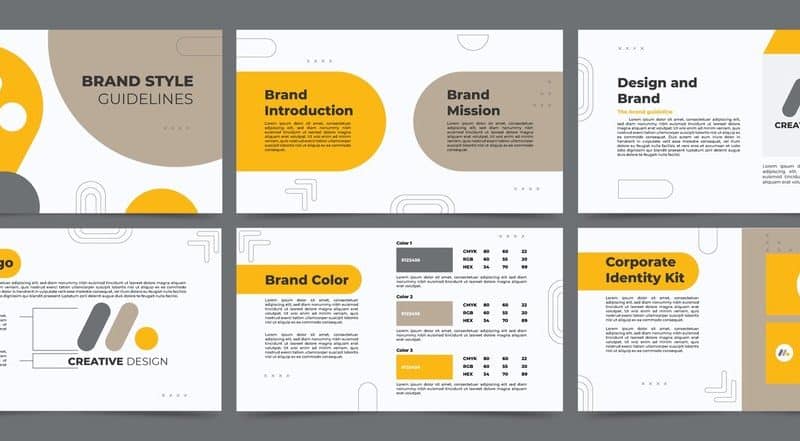Brand guidelines, often known as brand style guides, are the rules that allow you to convey your brand consistently. However, determining what to include in brand guidelines can be challenging. To help you create yours, I’ve highlighted an excellent brand guidelines example from well-known brands throughout the world. I’ll also talk about what makes these brand guideline examples special, as well as tips and tactics for creating your own.
Key Takeaways
- Brand guidelines, also known as brand style guides, are crucial for ensuring the consistent presentation of a brand across all platforms. They cover everything from logo usage to tone of voice, helping internal teams and external partners maintain a cohesive brand identity.
- Consistent use of brand elements as defined in brand guidelines helps build brand recognition, improve internal engagement, and align the entire organization with the brand’s values and messaging, leading to a more professional and trustworthy brand image.
- Essential elements of brand guidelines include the brand core (values, mission, and vision), logo usage, color palette, imagery, and brand tone of voice. These components guide the consistent use of brand assets across various mediums.
- Brands like TikTok, Spotify, Coca-Cola, Discord, Starbucks, OpenAI, and Apple have set excellent examples with their comprehensive brand guidelines, each focusing on different aspects that resonate with their target audience and reinforce their brand identity.
- The article provides downloadable templates and examples of brand guidelines from well-known brands, offering a valuable resource for businesses looking to create or refine their own brand guidelines, ensuring their brand is consistently represented.
What Are Brand Guidelines?
Brand guidelines, often known as a brand style guide, are a set of principles that specify how your brand should be presented across all platforms and touchpoints. These guidelines address everything from the use of your logo and brand colors to tone of voice and typography. They operate as a guide for everybody who interacts with your brand, whether they’re establishing a website, developing marketing materials, or writing a social media post.
What are the Benefits of Brand Guidelines?
Guidelines help customers connect with your brand by defining and documenting what it means. They transform “brand” from an abstract concept into something tangible that each team and employee can grasp and implement in their everyday job. Brand guidelines are crucial because:
- Increase internal engagement: Everyone on your team can access and use your brand guidelines, not just your creative teams. This increases employee ownership and allows them to independently generate on-brand communications, designs, and customer experiences.
- Improve consistency: Guidelines describe how to use various parts of your brand identity to create stuff that captures its essence. Providing the same criteria to internal teams, external partners, agencies, and freelancers guarantees consistency in materials.
- Build brand recognition: Consistency in images, speech, and conduct makes your brand appear professional and helps your audience recognize it.
Brand guidelines ensure that your entire firm aligns with your brand’s values, style, and messaging. They are where all of your workers and external partners learn how to communicate so that your customers may experience a genuine brand.
What Should You Include in Your Brand Guidelines?
#1. Brand core
The brand core is the foundation upon which a brand stands, holding its heart and soul. It is important to understand why a firm exists as well as what it does or offers. This identity is critical for directing decision-making, defining brand experiences, and matching the audience’s values and expectations. Let’s look at the components of the brand core.
- Brand values: Brand values are non-negotiable standards that serve as the brand’s ethical and operational backbone. Brand values influence behavior, decisions, and activities, ensuring that all aspects of the brand are consistent with these fundamental ideas. They serve to develop trust and loyalty among the audience by continually demonstrating what the brand stands for.
- Mission statement: This succinct statement expresses the brand’s purpose and reason for existence, which goes beyond profit. A well-crafted mission statement inspires and guides the brand’s efforts toward a unified purpose.
- Vision statement: Whereas the mission statement focuses on the present, the vision statement looks ahead, articulating what the brand hopes to become or achieve. It symbolizes the brand’s long-term goals, encouraging and motivating stakeholders to work toward this common goal.
Businesses that build a thorough brand core lay the groundwork for a powerful and long-lasting brand identity. This foundation not only guides internal plans and actions but also influences how the brand is viewed and experienced by the general public.
#2. Logo use
Your brand guidelines should describe how to use your company logos and include the following elements:
- Color variations: Include the necessary color variations, such as full color, black, and white, and specify when to utilize each version.
- Logo formats: Include complete, text, or wordmark logos, as well as single-line and square variations. Explain when to use which logo, and provide instances of each format in use.
- Logo Dos and Donts: Showcase proper logo usage across various backdrops (e.g., plain versus patterned) and channels (e.g., social media versus your website).
Uber, for example, has stringent brand guidelines that cover logo use, formats, and placement. As an international corporation, it also shows how to adapt its logo in languages that read right-to-left. This is a vital issue as your company scales into new markets.
#3. Color palette
Brand colors serve to increase brand recognition and make your company stand out. Incorporating your color palette into your standards is another approach to ensure consistency in your content and designs.
Include your brand’s color palette, including swatches that show what each color looks like and color codes for use in design tools. When you add color codes, include them in the appropriate formats (such as CMYK, HEX, and RGB) so that your team can use the correct colors when designing for print and digital.
#4. Imagery
Images showcase your products, emphasize your consumers, and promote your workers. A strong visual identity distinguishes your content in your clients’ social feeds, particularly if you use a distinct style from your competitors. In the long run, your choice of picture style and consistent visuals aid in brand identification.
Your guidelines should include instructions for using photos to develop designs that convey your brand identity. Creating on-brand graphics can be difficult for non-designers; therefore the more direction and examples you provide, the better. Here’s what your guidelines might cover:
- Image types include illustrations, photography, iconography, design components, and patterns.
- Guidance on when to use stock images
- Image categories include product, industry, company, aspirational, and headshots.
- Preferred color schemes for photos.
#5. Brand tone of voice
Voice and tone are sometimes overlooked in guidelines, as many businesses focus on the visual parts of their brand identity. However, how you write and talk is just as crucial for brand recognition as its appearance.
Documenting your brand voice in the guidelines ensures that your written, audio, and video content has a consistent voice and style. The tone of voice guidelines assist your team in maintaining a consistent brand voice, whether it’s a marketing campaign or a customer service ticket response.
For example, Buffer’s guidelines include advice on how to tailor its tone of voice to the demands of its customers. Its guidelines highlight the key aspects that comprise the brand voice:
Brand Guidelines Example
We’ll look at how these guides reflect the brand’s overall design approach, providing a detailed look at what makes them tick—and stick in people’s minds. Here are a few brand guidelines example below:
#1. TikTok
TikTok has a brand guide that details how their logo, fonts, and colors should look, as well as the overall vibe of the app. This thing is important because it helps TikTok stay in people’s brains and flourish. If you use TikTok, it’s important to understand these principles so that the site remains enjoyable and secure for all users.
#2. Spotify
Spotify’s visuals delivered a vivid, engaging experience that reflected its consumers’ expanding musical tastes. The strong shift toward duotone colors and contemporary design features was especially popular with millennials, who value visually exciting and experiential design.
However, Spotify did not simply make minor changes to its existing aesthetics; it took a huge, disruptive step. This brave move allowed them to stand out in a congested streaming scene. As a result, Spotify went from being just another music service to a lifestyle brand that truly understands the emotional impact of music.
#3. Coca-Cola
The Coca-Cola logo, a famous example of timeless design, has employed a red and white color scheme from its creation to represent passion, youth, energy, love, purity, and class. The logo, created in Spencerian script—a font used in the United States from 1850 to 1925—symbolizes the company’s founder’s vision for a distinct style. This logo is still relevant today, demonstrating that simplicity and alignment with a brand’s underlying values can result in an enduring visual identity. Rather than chasing design trends, the focus has always been on the brand’s goal, vision, and values, resulting in an enduring symbol that effectively communicates the Coca-Cola story.
#4. Discord
Discord prefers to keep things casual and enjoyable, stating that it is not the type of brand that takes itself too seriously. As more individuals, not just gamers, join Discord, it’ll be fascinating to see if the logo and feel remain effective. People like to call Discord’s logo “Clyde.” It appears to be a crab at first glance, but closer inspection reveals that it is actually designed like a gaming controller.
Discord has never said what Clyde is supposed to signify, so fans have come up with various ideas. The font they chose is distinctive and fits in perfectly with Clyde’s upbeat demeanor. Discord’s color scheme includes a cool blend of blue and purple known as “Blurple,” as well as white.
#5. Starbucks
The Starbucks Creative Expression guide provides a complete picture of how the Starbucks brand takes shape. Each aspect is carefully picked, from a palette based on a family of greens to logos that feature the Siren as the brand’s muse and face. The guide also discusses font rules and the need to use emotive content to showcase the brand’s distinct identity.
#6. OpenAI
OpenAI’s brand guidelines address a wide range of topics to maintain brand consistency and proper usage. The document begins by describing the language standards, then focuses on appropriate models and plugins, and finally specifies non-partnership and content attribution guidelines. It then digs into assets, including extensive directions on logos, such as spacing and sizing guidelines, as well as common pitfalls to avoid while using the logo. The rules also include sections on press release structure and terminology. Contact information is provided at the end of the guide in case you have more questions.
#7. Apple
Apple’s brand guidelines example offer a thorough roadmap for channel affiliates and Apple-certified professionals to ensure brand consistency. The guide addresses everything from channel signatures and typography to store identification and exterior design guidelines. It also covers the proper usage of Apple assets and product pictures, as well as reseller-specific naming and identity rules. The editorial guidelines outline how to use Apple authorizations and product names in writing. Finally, it covers trademark and credit line rules, ensuring that all external interactions are consistent with Apple’s identity.
Template Brand Guidelines
Templates are an excellent approach to ensuring consistency without always reinventing the wheel. Your brand guidelines should contain templates for common assets like business cards, letterheads, email signatures, and social media postings. These templates should be easily available and changeable to ensure brand consistency across all materials.
I previously worked for a company that struggled to maintain consistency in its social media updates. Each team member had their own style, resulting in a disorganized feed. By establishing a set of branded templates, we were able to expedite the process and ensure that each post looked and felt like it belonged to the same company.
“Ready to create a consistent and recognizable brand identity? Download our comprehensive Brand Guidelines Template and ensure your brand’s visual elements are aligned.”
Brand Guidelines Example PDF
For those interested in creating their own brand guidelines, I’ve included a free brand guidelines example PDFs and a template brand guidelines document. These materials are intended to help you get started and guarantee that your brand is represented consistently across all platforms.
Download the brand guidelines example PDF and the template brand guidelines to get started on your own brand guidelines,
- Apple Brand guidelines PDF
- The North Face Brand Guidelines PDF
- McDonald’s Brand Guidelines PDF
- Nasa Style Guide PDF
- Target Brand Guidelines PDF
- Slack Brand guidelines PDF
- Microsoft Brand style guide PDF
- Uber Brand Guidelines PDF
- Twitter Brand Guidelines PDF
- TikTok For Business Style Guide PDF
- Spotify Brand Guidelines PDF
- Twitch Brand Guidelines PDF
- Heineken Brand Guidelines PDF
- Adobe Brand Guidelines PDF
- Avast Brand Guidelines PDF
- American Express Brand Guidelines
- Issuu Brand Guidelines PDF
- AT&T Brand Guide PDF
- Motorola Style Guide PDF
- Olympic games Tokyo 2020 Brand Guide PDF
These materials have been really useful in my work, and I am convinced that they will assist you in maintaining brand consistency, building trust with your target audience, and eventually growing your business.
What is a brief for brand guidelines?
A brand brief provides a complete picture of what a brand is and is not. It explains your brand’s objectives, goals, values, and vision, allowing anybody involved in the creation of brand assets to effectively communicate the business’s direction, purpose, and positioning.
How to present a brand guideline?
Here are the basic steps to creating an effective set of brand guidelines for your business:
- Define your brand identity.
- Include your brand’s logo.
- Establish your brand’s color palette.
- Determine typography.
- Establish brand tone and voice.
- Set imagery guidelines.
- Provide usage guidelines.
- Update and evolve.
What is the difference between brand identity and brand guidelines?
A company creates brand guidelines to assist other businesses in providing their customers with a uniform brand experience. Brand identities are the attitudes, beliefs, and behaviors associated with a specific brand.
Conclusion
Brand guidelines are vital for developing a strong and consistent brand identity. By following the tips and guidelines mentioned in this blog post, you can build a comprehensive guide that will help your business stand out in a crowded market.
Have you got any questions about setting brand guidelines? Please share your ideas with us in the comments.
Related Articles
- Understanding the Difference Between Branding vs Logo
- Branding vs Positioning: Understanding the Difference
- Branding vs Trademark: What Every Business Owner Needs to Know
- A Better Approach to Building Your Personal Brand
- Branding vs. Advertising: Understanding the Difference






